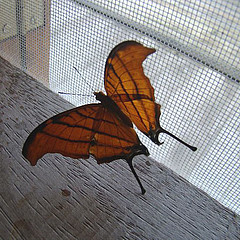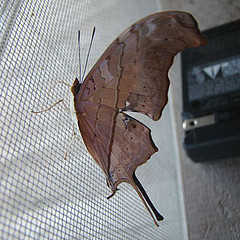Marpesia petreus (Cramer, 1776)
Ruddy Daggerwing
Papilio petreus (Cramer, 1776)
Marpesia petreus has a wide geographical distribution and uses many different habitats. The posture is maked with an egg deposited by branch. The caterpillars build a filament of excrement at the end of the leaf, where they stay when they are not feeding. This behavior happens even suffering the first ecdise. The life cycle lasts on average 31 days (Quadros et al. 2003). The adults do not agglomerate, to sleep solitary (Brown Jr. 1992).
Argentina; Belize; Colombia; Costa Rica; Cuba; El Salvador; México; Puerto Rico; Trinidad and Tobago; Uruguay; Venezuela
Adults feed on nectar and salts in mudpuddle
According compiled by Beccaloni et al. (2008) are recorded as host-plant:
Anacardiaceae: Anacardium sp., Anacardium excelsum, Anacardium occidentale
Leguminosae-Caesalpinioideae: Mora excelsa
Moraceae: Artocarpus sp., Ficus sp., Ficus benjamina, Ficus cahuitensis, Ficus carica, Ficus citrifolia, Ficus cotinifolia, Ficus goldmanii, Ficus microcarpa, Ficus obtusifolia, Ficus ovalis, Ficus pertusa, Ficus pumila, Ficus rubiginosa?, Maclura sp., Maclura tinctoria.
Rutaceae: Zanthoxylum fagara
brown, cream, orange
anthropogenic, open, open forest / meadow
- Quadros F.C., Nascimento J.C., Dorneles A.L., Corseuil E. (2003):
- Aspectos biológicos e morfológicos de Marpesia petreus (Lepidoptera, Nymphalidae, Limenitidinae). Biociências. 11(2): 173-176
- Brown Jr. K (1992):
- Borboletas da Serra do Japi: diversidade, habitats, recursos alimentares e variação temporal. In:n História Natural da Serra do Japi: ecologia e preservação de uma área florestal no Sudeste do Brasil., Campinas, Unicamp: 142-186
- Beccaloni G.W, Viloria A.L., Hall S.K., Robinson G.S. (2008):
- Catalogue of the hostplants of the Neotropical butterflies. Book., London, S.E.A., Ribes, CYTED, Natural History Museum, IVIC: 1-536





